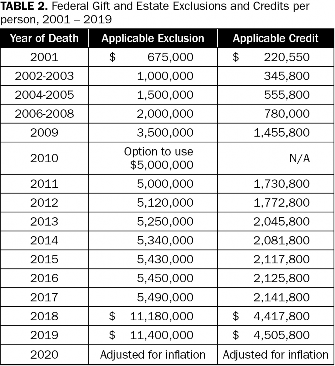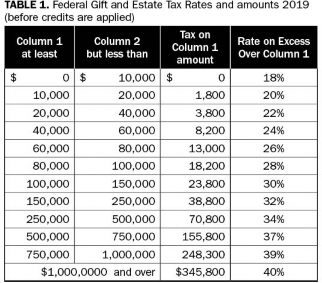
Federal Estate Tax
This publication describes how federal tax laws affect individual estates, including changes resulting from The Tax Relief, Unemployment Insurance Reauthorization, and Job Creation Act of 2010 and the American Taxpayer Relief Act of 2012.
Last Updated: 08/19by by Marsha A. Goetting, Ph.D., CFP®, CFCS, Professor and Extension Family Economics Specialist; Joel Schumacher, AFC®, Extension Associate Economics Specialist, Department of Agricultural Economics and Economics
THE FEDERAL ESTATE TAX IS A TAX ON THE
transfer of property at death. The amount of the estate tax depends upon the value of the assets the decedent (the person who died) held at death, taxable transfers during life, how assets are titled, deductions and available credits.
This MontGuide presents a general explanation of the federal estate tax provisions following the Tax Cuts and Jobs Act of 2017 and, when appropriate, the relationship to the companion federal gift tax. For further information see the MSU Extension MontGuide, Gifting: A Property Transfer Tool of Estate Planning (MT199105HR).
During 2019 the value of property that may be transferred free of the federal estate tax is $11.4 million per person (adjusted annually for inflation); $22,800,000 for a married couple. The Tax Policy Center estimates that less than 0.1% of estates will pay a federal estate tax in 2019.
The Gross Estate
Calculation of the federal estate tax on Form 706 begins with the determination of a deceased person’s gross estate. The gross estate includes: the fair market value of all real and personal property owned at death, transfers with retained life estates, transfers taking effect at death, revocable transfers, annuities, joint interests, certain powers of appointment, certain proceeds of life insurance, certain transfers occurring within three years of death, and future payments that were owed to the decedent at the time of death.
Valuation of Gross Estate
Generally, the value of the decedent’s property interest for federal estate tax purposes is the fair market value at the date of death. The IRS defines the fair market value as the price at which the property would change hands between a willing buyer and a willing seller, neither being under any compulsion to buy or sell and both having reasonable knowledge of all relevant facts. The personal representative may elect an alternate valuation of the assets as of six months after the decedent’s death. If the alternate valuation is elected, then all assets must be valued as of the alternate date, or as of the date of their distribution, sale, exchange, or other disposition, if any of those events occurs after a decedent’s date of death and before the alternate valuation date.
Basis of property
All property (real estate, stocks, and bonds) that a person owns has a basis for tax purposes. For example, a home purchased in 1978 for $47,000 has a basis of $47,000 even though its current fair market value in 2019 is $360,000.
Property received by a donee as a GIFT from a donor during life has a carry-over basis. This means the basis passing to the donee is the same amount as it was for the donor.
Example A: A father gives land to his daughter that has a fair market value of $3 million. The father paid $100,000 for the land. Because the transfer is a “gift,” her father’s $100,000 basis in the property carries over to the daughter. If she sells the property for $3 million, she is responsible for the income tax on the capital gain which is the difference between the basis ($100,000) and the fair market value ($3 million).
Thus, after the sale of the land the daughter would owe a federal income tax of $580,000 on the $2.9 million capital gain (assuming a long-term capital gains tax rate of 20 percent).
Most property received by a beneficiary from a decedent has a stepped-up basis. This means the basis of the property is stepped-up (or possibly down) to the fair market value at the date of death of the owner. However, some property passing at death takes a carryover basis. An example would be a traditional tax-deferred IRA account.
Example B: If the property in Example A had passed to the daughter as a result of her father’s death in 2019, she would have received a stepped-up basis on the property. This means the basis in the property would be stepped- up from the father’s $100,000 basis to $3 million, the fair market value at her father’s death. If the daughter sold the property for $3 million after her father’s death, there would be no income tax on the capital gain because she sold the property at the stepped-up basis of $3 million. If she sold the property for $4 million five years after she inherited it, she would be taxed on the gain of $1 million. Thus, after the sale of the land the daughter would owe a federal income tax of $200,000 on the $1 million capital gain (assuming a long-term capital gains tax rate of 20 percent).
Allowable Expenses and Deductions
After the appropriate values are established for the gross estate, the amount is reduced by subtracting the allowable expenses and deductions.
Expenses
Allowable expenses include such items as: administration expenses, funeral and medical claims against the estate, debt, and casualty and theft losses. Allowable deductions include the marital deduction and the charitable deduction.
Marital deduction
Generally, unlimited amounts of property can be transferred at death to a U.S. citizen spouse without federal estate tax. Tax free transfers at death to a spouse have to satisfy certain rules. For example, a Qualified Terminable Interest Trust (QTIP) requires an election on the Federal Estate 706 Form. The surviving spouse must be given unlimited income from the QTIP for life.
Charitable deduction
An unlimited deduction is allowed for the value of property in the decedent’s gross estate that was transferred to a charity by a will, a trust, a payable on death designation (POD), a transfer of death registration (TOD), or a beneficiary designation. These gifts must be made to a “qualified” 501(c)(3) charitable, religious, educational organizational or to a state, federal or local government.
Example C: In his will, a 4-H leader left land valued at $2 million to the Montana 4-H Foundation. The amount would qualify as a charitable deduction on the federal estate tax return because the Montana 4-H Foundation is a 501(c)(3) organization.
Federal Estate Tax Rate
After allowable expenses and deductions are subtracted from the gross estate, the federal estate tax rates are applied to the remaining balance (taxable estate). The federal estate tax is $345,800 on the first $1,000,000, and 40 percent of the amount over $1,000,000 (see Table 1). The result is termed the “tentative” estate tax.
Credits Deducted from the “Tentative” Federal Estate Tax
The following credits are deducted from the tentative estate tax: the unified credit (also termed applicable credit) and credit for tax on prior transfers. The applicable credit and applicable exclusion for both the federal estate tax and federal gift tax for the years 2001-2019 are listed in Table 2, page 3.
For deaths in 2019, a Federal Estate Tax Return (Form 706) is required only when the value of the taxable estate and the value of the prior taxable gifts total more than $11.4 million in 2019 (adjusted annually for inflation).
Unified Applicable Credit. The unified applicable credit is a credit against the tentative federal estate tax otherwise payable. During 2019, the applicable credit is $4,505,800 (see Table 2).
The applicable credit allows a decedent to pass $11.4 million (also called the basic exclusion amount) to any person in addition to any bequests made to a charity. However, the credit is reduced by the credit used for any taxable gifts made before death.
The applicable credit is applied against the estate tax otherwise payable. In other words, during 2019 the applicable credit of $4,505,800 is equal to $11.4 million per person in assets that can be transferred without being taxed at death. The same amount can be transferred during life without a gift tax. There is only one unified applicable credit, not one for federal estate transfers and another one for federal gift transfers.

Portability Provision of the Unused Exclusion for Married Couples. By taking advantage of the portability provision of the deceased spouse’s unused exclusion, the federal estate tax can be minimized in estates above $11.4 million at the death of the second spouse. With the portability provision, married couples can pass $22,800,000 ($11,400,000 + $11,400,000) free of the federal estate tax in 2018 (adjusted annually for inflation).
Example D: Jack died with an estate of $10 million that he left to his wife. His estate did not owe a federal estate tax because of the unlimited marital deduction. By utilizing Jack’s unused applicable credit and her own, no federal estate tax was due at her death because her estate did not exceed the exemption of $22,800,000.
Filing of Federal Estate Tax Return
If the value of the gross estate of a decedent and the value of taxable gifts are more than the applicable exclusion amount ($11.4 million in 2019 plus taxable gifts made during life), the federal estate tax return (Form 706), is due nine months after the date of death. A reasonable extension of time (not to exceed six months) to file the estate tax return, or related statements or documents, may be granted if it is impossible or impractical to complete the return within the normal nine-month period beginning at the decedent’s date of death.
Changing Regulations
The Tax Cut and Jobs Act of 2017 made changes in the federal estate tax statutes. While this MontGuide discusses some of the major changes, you are encouraged to consult competent professionals such as an attorney or certified public accountant to keep abreast of regulations as they develop. Also, consult these professionals to assist with legal documents to achieve your estate tax planning goals for your individual situation.
Further Information
The Internal Revenue Service provides in-depth publications on Federal Estate and Gift Taxation. They can be ordered from the IRS (1-800-829-3676) or downloaded at www.irs.gov.
Additional information about major changes in the regulations on gifting are explained in Gifting: A Property Transfer Tool of Estate Planning (MT199105HR). This MontGuide is available free from your local MSU Extension office, or at www.montana.edu/estateplanning and click Estate Planning Publications.
Acknowledgments
Representatives from the following reviewed this MontGuide and recommend its reading by all Montanans who are interested in the Federal Estate regulations.
- Business, Estates, Trusts, Tax and Real Property Section, State Bar of Montana
- Montana Society of Certified Public Accountants
Disclaimer
This publication is not a substitute for legal advice. Rather it is designed to help inform persons about the basic provisions of the federal estate tax law and to create an awareness of the need for planning if a person's goal is to minimize the tax. There are numerous exceptions and conditions to some of the concepts discussed. Future changes in laws cannot be predicted and statements in the MontGuide are based solely on the laws in force on the date of publication.


